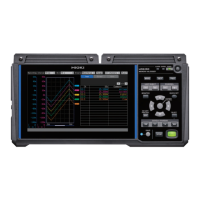107
FAQ (Frequently Asked Questions)
5.4 FAQ (Frequently Asked Questions)
Installation and measurement operation
Question Answer See
How long can the instrument operate
on battery power?
The instrument can operate for about 2 hours
on one fully charged Z1007 Battery Pack, or for
about 4 hours on two fully charged Battery Packs.
(Reference value at 23°C)
The wireless modules can work for ve to nine
hours (depending on the model type) with the
Battery Pack fully charged. (Reference value at
23°C)
“Continuous
operating time on
Battery Pack power”
(p. 44)
What will happen to data if the power
goes out during measurement?
No measurement data will remain. If electric
power to only a wireless module is interrupted,
the instrument will continue the measurement.
However, against a power failure, using the Z1007
Battery Pack is recommended.
“2.2 Installing a
Battery Pack”
(p. 40)
Can I resume recording once the
power comes back on?
Recording can be resumed when the power comes
back on by using the start state retention function.
“7.1 Conguring
Settings” in the
Instruction Manual
Why does temperature error increase
immediately after the instrument is
moved to a location with a signicantly
dierent temperature?
When measuring temperature with a thermocouple,
the terminal temperature is measured by an
internal temperature sensor and used to perform
reference junction compensation. When the
ambient temperature changes abruptly, the
thermal balance between the terminal block and
the temperature sensor is interrupted, causing
temperature error. When moving the instrument to
a location with a signicantly dierent temperature,
allow the instrument to sit for at least 60 minutes
before performing measurement.
“Installing the
Instrument” (p. 8)
How can I correct for dierences in
the zero position of dierent inputs?
The zero-adjustment function can be used to
correct for such dierences. The zero-adjustment
function is disabled for the Strain Units (U8554,
LR8534). You can correct the zero position of the
Strain Unit using the auto-balance.
“1.9 Performing
Zero Adjustment”
"Measuring strain"
in the Instruction
Manual
I’m seeing waveforms for unconnected
channels even though I’m only
providing input for channel 1.
If the input terminals are left open, the instrument
may display waveforms that have been aected
by other channels. Either disable the channels
with open inputs or short the positive and negative
terminals.
–
Displayed values are uctuated even
when no voltage is applied.
Displayed values can frequently
uctuate due to induction potential
even when no voltage is applied. This,
however, is not a malfunction.
–
Can I assign a mark during
measurement and search for it later?
You can assign event marks in waveforms. You can
jump to event mark locations on the display.
“5.1 Assigning
Event Marks during
Measurement” in the
Instruction Manual
When using wireless units, there will
appear to be dierences in sampling
timing between units.
The dierence will be about 20 ms with robust
wireless communications and more when the
networking signal is weak.
“1.16 Measurement
Data” in the
Instruction Manual
Maintenance and Service

